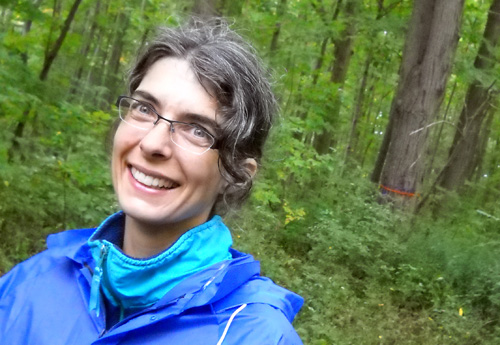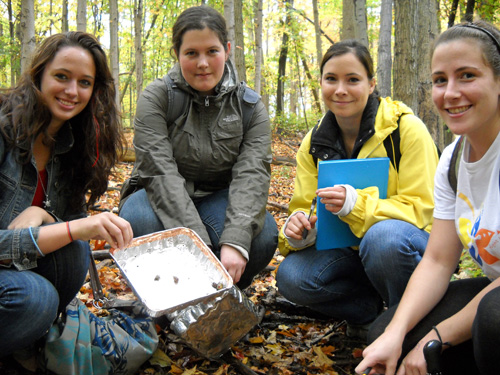At Guelph presents a series of stories that highlight University of Guelph leadership in teaching excellence and the scholarship of learning.

Lurking on the edge of the forest, it awaits its prey. It’s a black and yellow garden spider, waiting for lunch to blunder into its rain-beaded web strung among weeds and grasses on the northern perimeter of the campus dairy bush.
Argiope aurantia doesn’t know it, but there’s something stalking it in turn. Or someone: Lauren Jarvis, a fourth-year biology undergrad, out to learn more about prey-predator relationships. And that small predator is oblivious to four other senior students prowling through this century-old woodlot, checking their aluminum baking pans for captive snails in another study of who eats whom.
There’s a lot going on in the dairy bush, a seven-hectare living laboratory on the northwest corner of the Guelph campus. Within earshot of traffic out on Edinburgh Road, hundreds of students and their instructors visit each week to learn about aspects of ecology in a natural hardwood forest unlike anything available on many other university campuses.
“It’s a compact, contained area that makes it easy to work in,” says April Nejedly. Glancing up at the canopy of maple, beech and ash, she says, “It’s an exciting world, it’s natural, it smells different, there’s always something alive in the forest. It’s a real eye-opener into field biology.”
Nejedly co-ordinates “Discovering Biodiversity,” a new course begun in 2010 under a first-year curriculum revamping within the College of Biological Science (CBS).
In that course, a total of 1,700 first-year students – 1,100 in fall, 600 in winter – conduct field work in the dairy bush. For several weeks each semester – morning and afternoon, four days a week – groups of 60 at a time visit the woods to learn about the interplay of plants, animals, microbes, light and soil in this century-old natural setting.
Those first-year students are not the only learners in this outdoor classroom. In Prof. Andy Gordon’s fourth-year “Forest Ecology” course, about 45 students complete outdoor lab assignments here and in a smaller patch nearby called Brown’s Woods.
“It’s what you’d call a remnant woodlot,” says the professor in the School of Environmental Sciences. His students study how energy and nutrients cycle through forest ecosystems here and in the U of G Arboretum.
Back in CBS, about 30 students in another fourth-year course called “Ecological Methods” visit the dairy bush in the fall to study such topics as prey-predator relationships and restoration ecology.
“Groups of students work like a grad student,” says Prof. Kevin McCann, Integrative Biology. “They learn how to be a scientist. It’s like a large field course.”
McCann inherited that course from retired professor Doug Larson, along with documents and photographs tracing the history of the forest plot since the late 1800s.
The rectangular woodlot actually consists of two parts, one east and one west. The section closest to Edinburgh Road is the so-called natural forest, with the oldest maples dating back to 1785 (before the founding of Guelph).
In the late 1800s, the section of today’s bush closest to campus was used as a cattle and sheep run. In 1887, that section was cleared and planted with trees, including pine, tamarack, maples, walnut, ash, basswood and elm.
Although some of those plantings died, and although both sections were partially harvested for firewood, the entire dairy bush has been permitted to naturally regenerate since 1910.

It was that fourth-year “Ecological Methods” course that brought Jasmine McCulligh and three classmates into the dairy bush one recent afternoon to check their baking pan traps for native and invasive snails. “You see interactions first-hand,” says McCulligh.
Biology student Jarvis also visits the dairy bush routinely, not for a class but for her fourth-year project. She’s tracking spiders to learn about predatory tactics on the boundary between the woods and an adjoining field. “I’m using spiders as an example of a sit-and-wait predator at the edge,” she explains.
Whether it’s the forest and field or other side-by-side habitats, interactions and biodiversity “at the edge” interest ecologists, says Tyler Tunney. A PhD student and former TA in McCann’s course, he’s interested in how open-water creatures interact with near-shore prey.
Referring to Jarvis’s study, he says, “It’s cool, having use of the dairy bush, right out our back door. We can get a preliminary and novel look at how web-building predators and their prey interact across forest and field habitats.”
Using the campus woodlot as a model in a different way, biology student Sandra McCubbin investigated insect diversity there as training for her research sampling in Algonquin Park this past summer. She’s now a geography master’s student at Guelph.
No one has yet counted the total number of insect species in the dairy bush, says integrative biology professor Alex Smith. He has set up canopy and ground traps to monitor organisms, like one otherworldly parasitic wasp now preserved in his lab. The creature wields its lengthy ovipositor like a needle to stab the larva of another wasp before laying its eggs inside the prey.
For two years, Smith has also monitored the forest using a GigaPan camera. On his website, he posts the result of his weekly forays, allowing users online to peruse his panoramic photos for plants, animals and insects – and occasionally Smith himself.
He has also posted a series of videos about dairy bush ecology, shot with Profs. Ryan Gregory and Steven Newmaster.
Newmaster currently co-teaches “Discovering Biodiversity.” Students in that first-year course use the dairy bush as a case study to learn about the effects of disturbance on the landscape. From a grid map of the woodlot, they are given plots to study, like being assigned to benches in a Science Complex teaching lab.
Newmaster says many students view the outdoor classroom as an unexpected bonus at Guelph. They are also surprised by its diversity.
The woodlot is home to more than 100 plant species and a few rare lichens; many are included along with birds and mammals in Woodlot Biodiversity, an illustrated text edited in 2010 by Newmaster and co-authored by several Guelph biologists.
It was shortly after he joined the U of G faculty in 2002 that he began taking students to the woodlot to get a look at what he calls a representative southern Ontario forest. “It has all the classic species you’d see in a deciduous forest region.”
His own exposure to the dairy bush goes further back than that. He studied ecology with Larson in the late 1980s. “I remember him going out and pointing to trees and asking: ‘How did these get here?’ It was just so real to me, it was very engaging. Students learn much better when they’re in the field. ”
This fall, his co-instructor is Prof. Patricia Wright, Integrative Biology. Referring to their first-year students, she says, “It’s great to have them working as biologists in the field, because there’s a perception that science is done in the lab with lab coats on. Fewer students have had the experience of immersing themselves in an ecosystem. We’ve focused on skills training to identify plants and methods to analyze species diversity.”
Never mind the critters: That teaching unit in the campus dairy bush also introduces students to basic science smarts, says Gregory. He co-taught “Discovering Biodiversity” twice in its first year. After a break this fall, he will return in the winter semester with Prof. Glen Van Der Kraak, Integrative Biology.
Says Gregory: “We emphasize skills in inquiry and scientific thinking and concepts not otherwise covered until a senior course.”
Gregory, Wright, Newmaster and Nejedly led a departmental team in designing that first-year course, introduced in fall 2010. The dairy bush unit covers forest ecology; other themes in the course are evolution and physiology.
Two other linked courses introduced in U of G’s new first-year biology curriculum look at health and molecular and cellular biology.